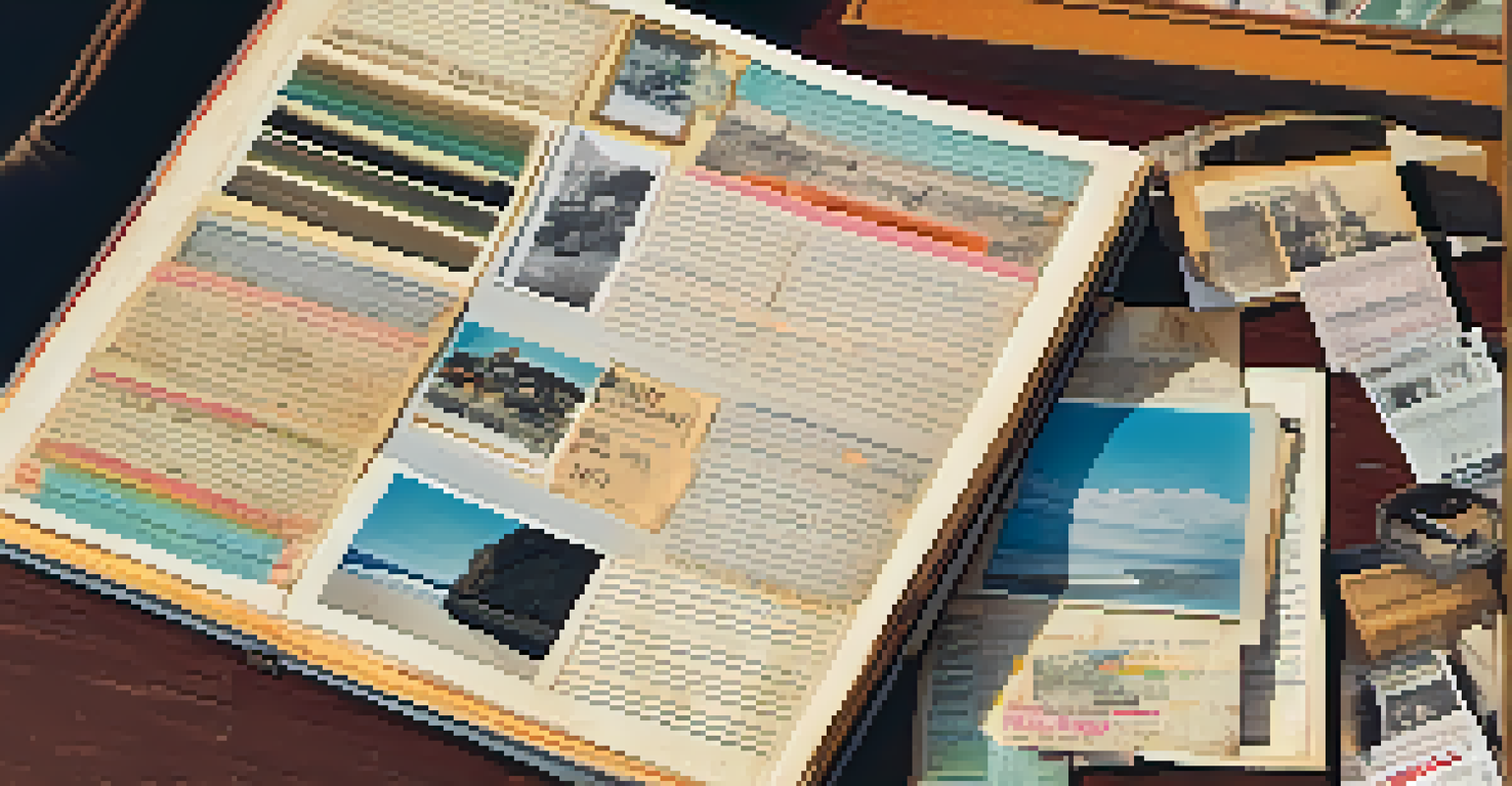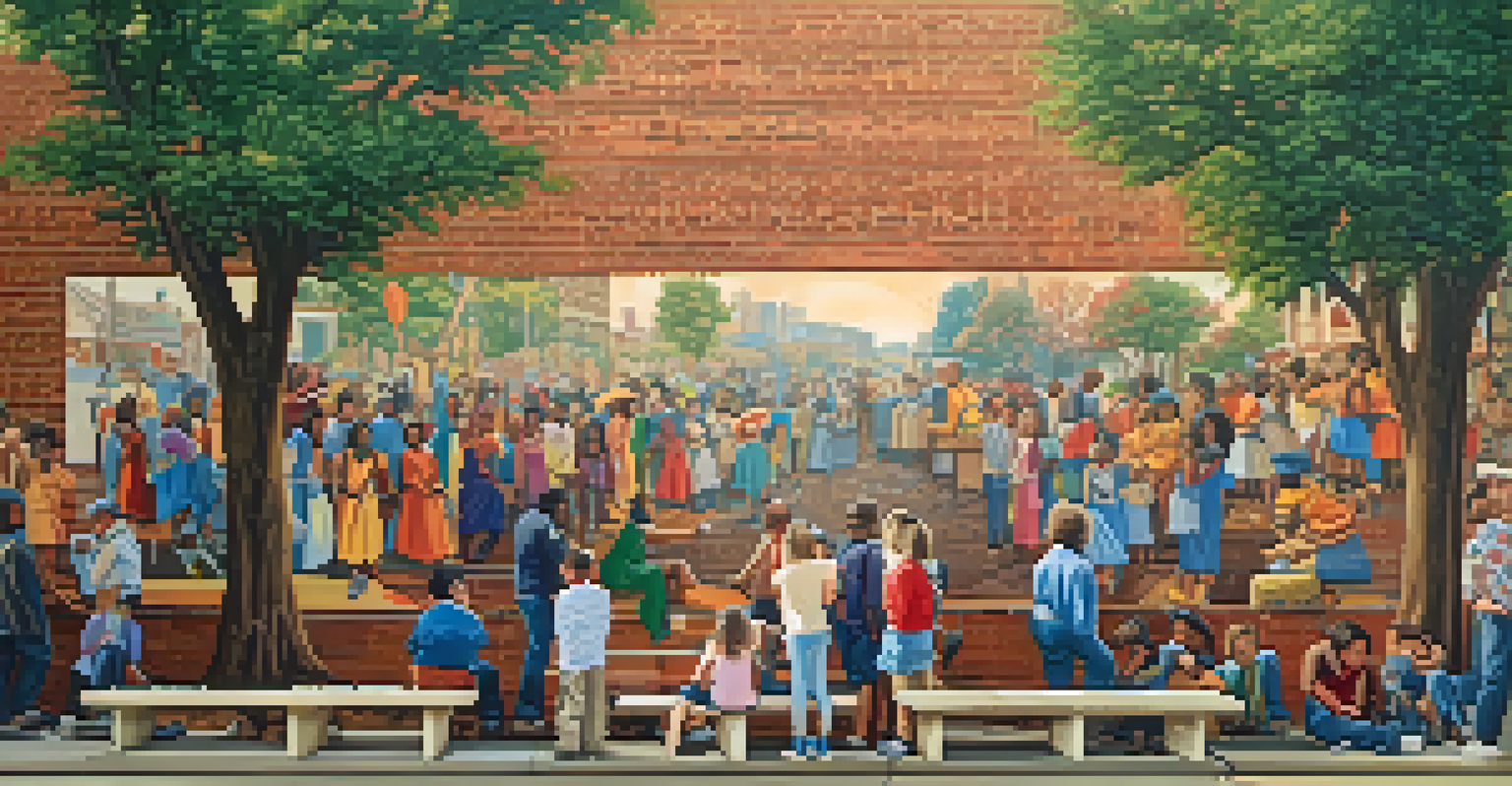Art and Memory: Preserving the Past Through Visual Stories

The Power of Art in Shaping Memories
Art has a unique ability to evoke emotions and memories that words often cannot express. It serves as a bridge between our past experiences and present understanding, allowing us to reflect on moments that have shaped our lives. For instance, a painting of a family gathering can instantly transport us back to that joyful day, making the memory feel vivid and accessible.
Art is the most beautiful of all lies; it is the one that tells the truth about the world.
This emotional connection is what makes art a powerful tool for preserving memories. Whether it’s through photography, painting, or sculpture, the visual representation of moments allows us to revisit them anytime we wish. It’s as though the artwork captures a snapshot of time, preserving not just the image, but the feelings associated with it.
Moreover, art can enhance our collective memory, giving voice to shared experiences. Communities often use murals or public installations to commemorate significant events, ensuring that future generations remember their history and heritage.
Visual Storytelling: A Window to the Past
Visual storytelling is the art of communicating experiences and narratives through imagery. This technique allows artists to depict historical events or personal stories, creating a connection between the viewer and the subject matter. A powerful example is the use of documentary photography, which captures real-life moments that tell stories of struggle, joy, and resilience.

These visual narratives not only document history but also invite viewers to engage with the past on a deeper level. When we see an evocative photograph from a pivotal moment, we are drawn into the emotions and experiences of those portrayed, fostering empathy and understanding. It’s like peering through a window into another world, feeling the weight of history.
Art Evokes Powerful Memories
Art serves as a bridge to our past, evoking emotions and memories that help us reflect on significant moments in our lives.
As a result, visual storytelling plays a crucial role in preserving cultural memory. It highlights the importance of remembering our past, ensuring that stories are not lost to time but instead celebrated and shared across generations.
Art as a Personal Memory Keeper
For many individuals, creating art is a deeply personal way to preserve memories. Art can serve as a diary, where each stroke of the brush or click of the camera encapsulates a moment in time. Artists often draw inspiration from their own life experiences, translating them into visual forms that resonate with their audience.
Every artist dips his brush in his own soul, and paints his own nature into his pictures.
Take, for example, a scrapbook filled with photographs, ticket stubs, and handwritten notes. Each element tells a story, capturing the essence of a particular time and place. This personalized approach to memory preservation allows individuals to reflect on their journeys, celebrating milestones and learning from challenges.
In this way, art becomes a tangible representation of our personal histories. It not only helps us remember but also encourages us to share our stories with others, fostering connections and understanding through shared experiences.
Cultural Artifacts: Keeping History Alive
Cultural artifacts, such as traditional crafts and historical paintings, play a significant role in preserving collective memory. These pieces of art serve as reminders of our cultural heritage, reflecting the values, beliefs, and experiences of different communities. By studying and appreciating these artifacts, we gain insight into the past, enriching our understanding of different cultures.
For instance, indigenous art forms often convey stories and teachings passed down through generations. Each piece is infused with meaning, serving as a visual record of traditions and histories that might otherwise be forgotten. In this way, cultural artifacts become essential tools for education and remembrance.
Visual Storytelling Connects Us
Visual storytelling allows artists to communicate experiences and narratives, fostering empathy and understanding of shared histories.
Moreover, the preservation of these artifacts is critical for future generations. Museums and cultural institutions work tirelessly to maintain and exhibit these treasures, ensuring that the stories they tell continue to be shared and celebrated.
Art and Memory in Digital Age
The digital age has transformed how we create and preserve art, making it more accessible than ever. With the advent of photography and digital media, individuals can now capture and share their memories instantly. Social media platforms allow us to document our lives in real-time, creating a digital archive of our personal histories.
However, this shift also raises questions about the authenticity and permanence of digital memories. Unlike physical artworks, digital images can be easily altered or lost, leaving us to ponder how well they truly preserve our past. As we navigate this new landscape, it’s essential to consider the value of tangible art forms that provide a lasting connection to our memories.
Despite these challenges, the digital age offers exciting opportunities for creative expression. Artists can explore new mediums and engage with audiences in innovative ways, ensuring that the stories of our time are preserved for future generations in a variety of formats.
The Role of Artists in Memory Preservation
Artists play a crucial role in the preservation of memory through their unique perspectives and interpretations. By capturing moments and emotions, they create works that resonate with viewers on a personal level. This connection fosters a sense of shared history, reminding us of our collective experiences and emotions.
Moreover, artists often challenge us to confront uncomfortable truths about our past. Through thought-provoking pieces, they encourage dialogue and reflection on historical events that may be difficult to face. This critical engagement with memory is essential for healing and understanding, allowing communities to move forward while honoring their histories.
Digital Age Transforms Memory Art
The digital age has changed how we create and preserve art, providing new opportunities while raising questions about the permanence of digital memories.
Ultimately, artists serve as storytellers, shaping our understanding of the past through their creative expressions. Their work encourages us to remember, reflect, and engage with our shared human experience.
The Future of Art and Memory Preservation
As we look to the future, the intersection of art and memory preservation continues to evolve. New technologies, such as virtual reality and augmented reality, offer innovative ways to experience and interact with art. Imagine walking through a digitally recreated historical event, fully immersed in the sights and sounds of the past—it's a thrilling prospect.
At the same time, we must consider the importance of traditional art forms and the stories they convey. While technology can enhance our experiences, the tactile nature of physical art holds a unique power that should not be overlooked. Balancing these modern advancements with the preservation of traditional methods will be essential for maintaining our connection to history.

Ultimately, the future of art and memory preservation lies in our ability to adapt and innovate while honoring the past. By embracing new tools and techniques, we can ensure that our stories and memories continue to thrive in an ever-changing world.